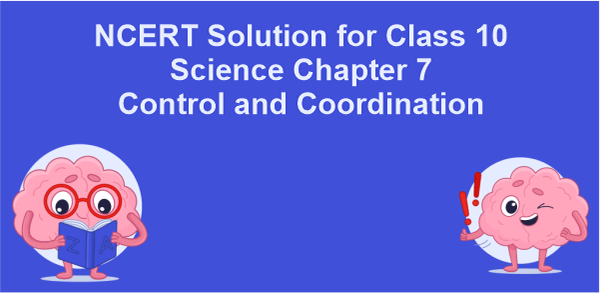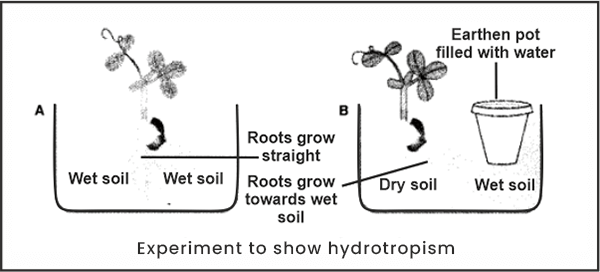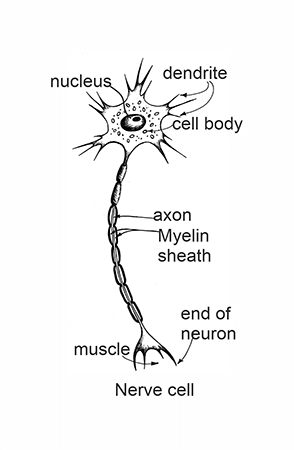NCERT Solutions for Class 10 Science Chapter 7 Control and CoordinationNCERT Solutions For Class 10 Science Chapter 7 Control And Coordination: In this article, we have prepared a proper solution of the NCERT questions of class 10 science chapter 7. These solutions will be very helpful for students who are appearing for any kind of exams. 
These questions are given with proper explanation so the theory parts could also be covered. This way the solutions will be helpful for those students also who haven't read the theory part. From these solutions only the theory part along with the questions will be covered. Apart from these, the solutions will also help students to complete their any kind of home work which in return saves time. So students can save their time for self study. NCERT Solutions Class 10 Science Chapter 7 Inside Book QuestionsPage Number: 119Question 1: What is the difference between a reflex action and walking? Answer: Difference between reflex action and walking is as follows:
Question 2: What happens at the synapse between two neurons? Answer: There exist a small space between two nerve cells, and that part is called the synapse. The main function of the synapse is that any information that needs to be passed from one neuron to another occurs at this point, i.e., at the synapse. Each neuron has axons, and when information needs to be passed to the next neuron at the synapse, the end of the axons produces a chemical substance. The chemical substance is passed on to the next neuron through the dendrites of the neuron. This way, information is transmitted from neuron to neuron at the synapse. Question 3: Which part of the brain maintains posture and equilibrium of the body? Answer: The cerebellum, also called the small brain, is mainly responsible for maintaining the body's equilibrium and posture. For Example, A drunk man cannot walk properly because the alcohol prevents the cerebellum from functioning properly, as a result of which it is unable to maintain the balance of the body. Question 4: How do we detect the smell of an agarbatti (incense stick)? Answer: A burning agrabatti produces smoke which is a gas. Now, this gas diffuses with the air. When our nose inhales this diffused air, the olfactory receptors detect it. This olfactory receptor is also known as the smell receptor. This receptor is present inside the nostril. It is a protein whose function is to bind odor molecules. After detecting the odor, the receptor sends this information to the olfactory lobe of the forebrain through sensory nerves. After receiving the information, the brain responds to it, and because of this reason, we can detect the smell of agrabatti or any other kind of smell. Question 5: What is the role of the brain in reflex action? Answer: Reflex action is a kind of response that happens suddenly and automatically. This action is mainly controlled by the spinal cord and doesn't involve thinking. Since it does not involve thinking, we can say that the brain doesn't play any role in a reflex action, which is correct. Any action without the involvement of the brain is called involuntary action. Therefore, the reflex action is also a kind of involuntary action. Below, an example is given of why the brain is not involved in a reflex action. Suppose a friend of yours is holding a cup of hot tea, and mistakenly the tip of your finger touches the cup. You feel hot and instantly remove your hand. This action is an example of reflex action as it occurs very fast without the involvement of the brain. If the brain was involved, stimuli would be first sent to the brain, where it would detect what type of information it is, and then the brain would respond accordingly. So this process would take much longer time than reflex action and may cause a severe burn. Page Number: 122Question 1: What are plant hormones? Answer: Hormones are a kind of chemical substance that facilitates any physical properties. For example, the adrenaline hormone gives humans extra power during a fight or flight. Similar way, plants also have hormones which are known as phytohormones. These phytohormones in plants are responsible for the growth, height, or any other kind of development which happens in a plant. There are various kinds of phytohormones available in plants. Some of them are auxins, ethylene, abscisic acid, gibberellins, and cytokinins. Question 2: How is the movement of leaves of the sensitive plant different from the movement of a shoot towards light? Answer:
Question 3: Give an example of a plant hormone that promotes growth. Answer: The hormone which facilitates the growth in plant is known as Auxin. Question 4: How do auxins promote the growth of a tendril around a support? Answer: Tendrils are modified parts of plants that help plants to achieve extra support. These tendril keeps growing to give more and more support to the plant. Tendril is mainly found in plants having weak stems, like in money plants. The growth of the tendril is facilitated by the growth hormone of plants called auxins. Auxin hormone is present at the tip of the tendrils, and when the tendrils touch any support, the auxins move to the side of the tendril away from the support. This way, the auxins help grow a tendril in plants. Since the side of the tendril away from the support carries more auxins, that tendril grows faster than the tendril, which is in contact with the support, and thus the tendril twirls around the support, making the plant stronger. Question 5: Design an experiment to demonstrate hydrotropism. Answer: Hydrotropism is a property in plants where the root grows in a direction where water concentration is higher. This mainly happens when the roots of the plants are unable to find water or very less water. Example to demonstrate Hydrotropism in plants. 
First, take two glass troughs and mark one as A and the other as B. Fill each of the troughs with soil. Ensure that the trough is filled with only up to two-thirds of the soil. Plant a tiny seedling in trough A. In trough B, place two things. First, a similar seedling as in trough A and a clay pot filled with water. The trough B has seedlings and a clay pot filled with water, as shown in the picture above. Water the trough uniformly and daily to keep the soil moist. Do not water through B but make sure that the clay pot has water. Now leave both troughs for a few days. After a few days, dig the seedling from both troughs. Make sure that seedlings are taken out carefully without damaging the roots. You will notice that roots of the seedling in trough B has a different growth pattern than the root of the seedling in trough A. The roots of the seedling in trough A would be straight, while the roots of the seedling in trough B would appear to be bent towards the side on which the clay pot filled with water was kept. The above scenario happened because the seedling in trough A was getting water consistently, as a result of which the soil was moist throughout, and the root was able to draw water from both sides, and it grew straight. So from the above experiment, it is clear that if the roots of the plants are not getting enough water, then the roots start growing towards the direction of the water. Thus we can say that roots of the plant show the hydrotropism property. Page Number: 125Question 1: How does chemical coordination take place in animals? Answer: The nervous system of our body, along with the endocrine gland, is responsible for coordination in our body. Hormones secreted by endocrine glands present in animals regulate and coordinate chemical coordination. Thus, this cycle is also known as the endocrine system. Hormones secreted by endocrine glands are directly released into the bloodstream of the animals, and it directly reaches the targeted cells. The cells receiving hormone acts accordingly to the information carried by those hormones. The cells have a special type of functionality that helps them detect the hormone's presence. Question 2: Why is the use of iodised salt advisable? Answer: Iodised salt contains iodine, and the thyroid gland in our body needs iodine to secrete thyroxine hormone. The thyroxine hormone's main function is to control our body's metabolic activities. The thyroxine hormone controls protein metabolism, carbs, fats, etc. Lack of thyroxine may result in a disease known as goitre. Question 3: How does our body respond when adrenaline is secreted into the blood? Answer: Adrenaline is a kind of hormone secreted by our body's adrenal gland. This hormone is secreted during an intense moment to give the body extra power. The adrenaline hormone is secreted when we are too scared or in a fight mode. So during flight or fight, the adrenal gland secretes adrenaline hormone. During the flight or fight condition, the blood flow of our body increases, as a result of which the heartbeat is also increased. The adrenal gland secrets adrenaline hormone so that more oxygen-rich blood is supplied to the muscles. The small arteries around the skin and digestive system contract, as a result of which blood flow decreases, and because of this reason, the blood flow toward the skeletal muscle is increased. During this intense flight or fight moment, the breathing rate increases because of the rib muscles and diaphragm's contraction. All these functionalities help us to face any fear or anger situations. Question 4: Why are some patients of diabetes treated by giving injections of insulin? Answer: Insulin is a hormone responsible for regulating sugar levels in the blood. If insulin is not released properly, blood sugar levels may rise, leading to some diseases and other harmful effects. So to treat diabetic patients, insulin injections are given to maintain the sugar level in the blood. NCERT Solutions for Class 10 Science Chapter 7 Exercise QuestionsQuestion 1: Which of the following is a plant hormone?
Answer: d.) Cytokinin Question 2: The gap between two neurons is called a
Answer: b.) Synapse - It is the place where the information from one neuron is transferred to next neuron by releasing chemical substances. Question 3: The brain is responsible for
Answer: b.) All of the above Question 4: What is the function of receptors in our body? Think of situations where receptors do not work properly. What problems are likely to arise? Answer: There are various specialized cells present in our sense organs. Those specialized cells are known as receptors. Receptors are used to receive information from the environment. When an incense stick is lit, we immediately receive the stick's smell because of the olfactory receptors inside the nostril. Receptors are very important because if the receptors do not function properly, they won't be able to communicate with the brain or spinal cord properly, and this may cause harm to our bodies. If the receptors on the skin get damaged and we touch a hot object, the response of removing the hand will be delayed because of the damaged receptors. This delayed response may cause burn to the hands or any other accident. Question 5: Draw the structure of a neuron and explain its function. Answer: 
A neuron or nerve cell is the main part, or you can say it is the functional unit of the nervous system. It has three main parts: the cell body, dendrite, and axon. The function of a Neuron: The main function of the nerve cells is to carry information through electrical signals, also called nerve impulses. They receive inputs from the outer world, transmit to various parts of the body like the brain and spinal cord, and carry the message from the brain or spinal cord to the targeted organs. The ends of the neurons contain a gap known as a synapse, where information from one neuron is transmitted to another. Question 6: How does phototropism occur in plants? Answer: Movement in any part of the shoot system in plants is because of phototropism. The property of phototropism in plants occurs due to light. Phototropism property in plants is mainly exhibited due to auxin hormones. When light falls on one part of the plant, the auxin hormone is secreted in large quantities in the shady part. Thus these auxin hormones help in the growth of plants in shady part, because of which plants seems to bend towards the light. Question 7: Which signals will get disrupted in case of a spinal cord injury? Answer: Mainly the two functionalities of the human body will get disrupted if the spinal cord gets injured. i.) Firstly, all involuntary actions will be disturbed as the spinal cord controls them. ii.) Reflex action will also get disturbed because the spinal cord controls and coordinates reflex action in our body. In short, the sudden response used to safeguard our body will not be properly functional. Question 8: How does chemical coordination occur in plants? Answer: Plant hormones are responsible for chemical coordination among them. Plant hormone receptors are secreted by stimuli cells in those regions where cell division occurs. The hormone secreted detects the information and communicates it to all the nearby cells. Question 9: What is the need for a system of control and coordination in an organism ? Answer: Control and coordination in organisms are mainly for the following reasons: i.) It helps organisms to adapt themselves according to the changing environment. ii.) It also helps to control the speed and movement of involuntary and voluntary actions. iii.) It also helps to think and respond to any stimuli. Question 10: How are involuntary actions and reflex actions different from each other? Answer:
Question 11: Compare and contrast nervous and hormonal mechanisms for control and coordination in animals. Answer:
Question 12: Compare and contrast nervous and hormonal mechanisms for control and coordination in animals. Answer:
Next TopicClass 10 Science Solution Chapter 8
|
 For Videos Join Our Youtube Channel: Join Now
For Videos Join Our Youtube Channel: Join Now
Feedback
- Send your Feedback to [email protected]
Help Others, Please Share









